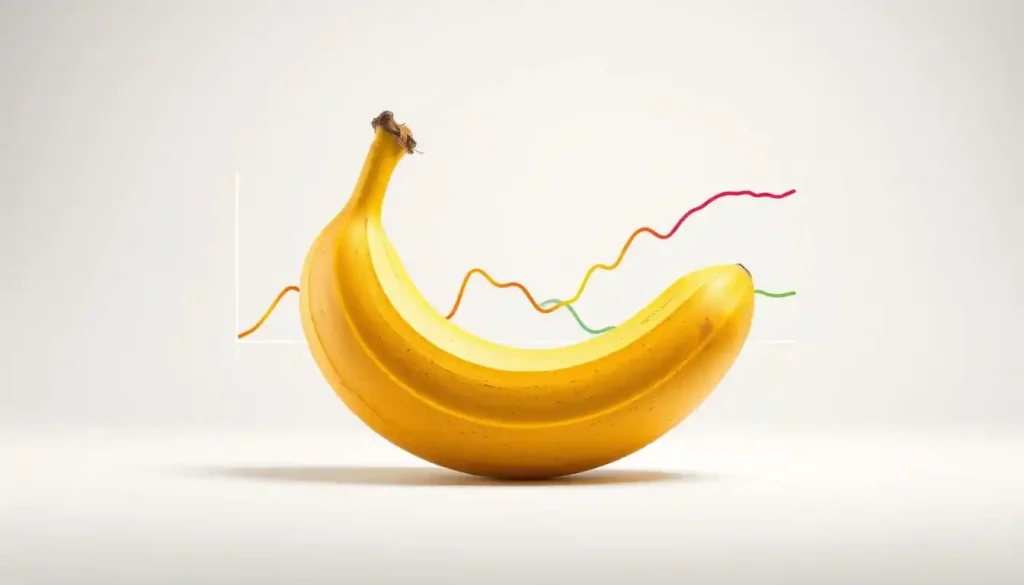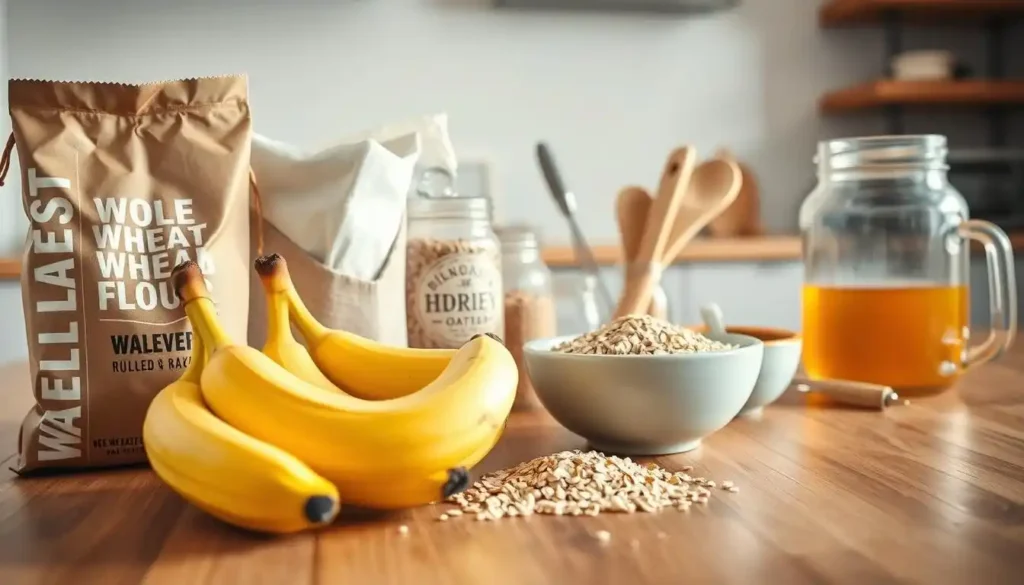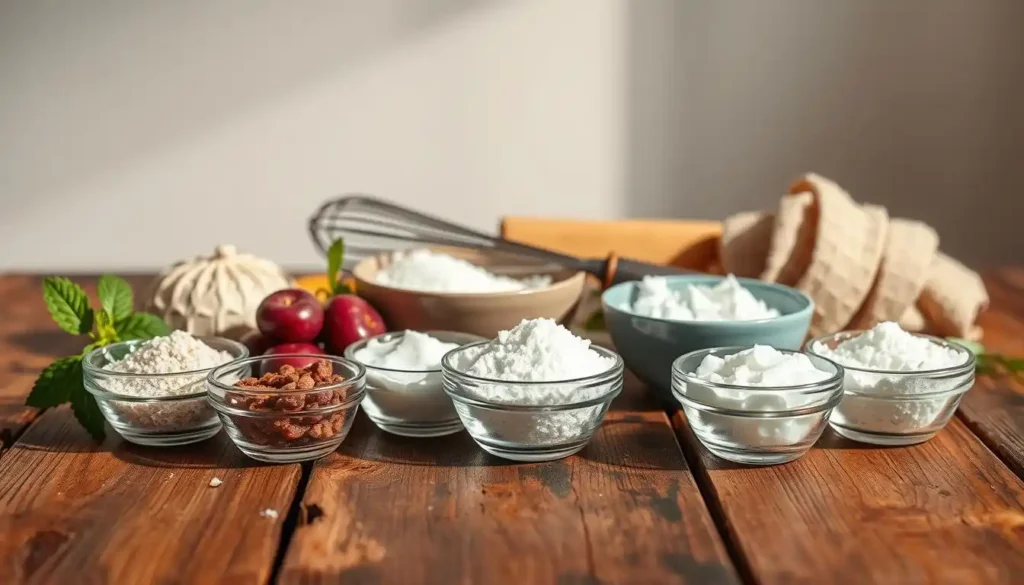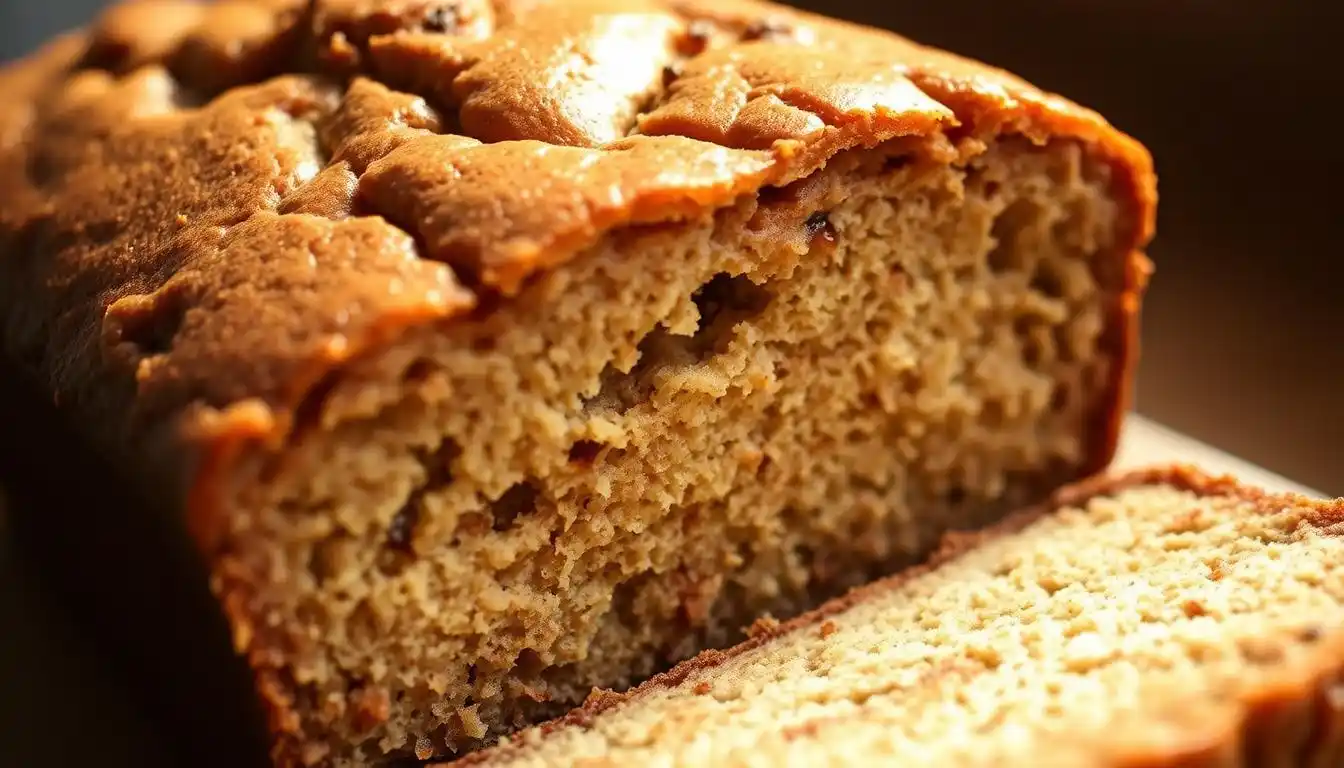Looking for a healthy dessert that fits your diet? Our sugar-free banana bread is tasty and full of nutrients. It can help increase your energy.
This diabetic banana bread recipe is made for diabetics. It uses safe and healthy ingredients. Enjoy a sweet treat without worrying about your blood sugar.
Table of Contents
Key Takeaways
- A healthy dessert option for diabetics
- Boosts energy levels with nutrient-rich ingredients
- Sugar-free and safe for diabetic diets
- Delicious and satisfying treat
- Carefully selected ingredients for maximum health benefits
Understanding Diabetes and Baking Challenges
If you have diabetes, you know how hard it can be to bake, especially banana bread. It’s important to know how ingredients affect your blood sugar. This lets you enjoy your favorite treats safely.
Traditional banana bread recipes can raise your blood sugar quickly. This is because they have a lot of carbs and sugar. High glycemic foods can make it hard for diabetics to keep their blood sugar in check.
The Glycemic Impact of Traditional Banana Bread
Traditional banana bread recipes use refined flour, sugar, and ripe bananas. These ingredients make the bread high in carbs and sugar. This can be a problem for diabetics because it can cause their blood sugar to spike.
- Refined flour lacks fiber, causing quicker digestion and absorption.
- Added sugars directly increase the glycemic load.
- Ripe bananas, while nutritious, are high in natural sugars.
Why Bananas Can Be Tricky for Diabetics
Bananas can affect your blood sugar, especially if they’re ripe. They’re full of good nutrients but also have a lot of natural sugar. This can be hard for diabetics to manage.

The Need for Energy-Boosting Alternatives
Traditional banana bread can be tough for diabetics to handle. There’s a need for recipes that help manage blood sugar and keep energy up. By making some changes, you can enjoy banana bread without worrying about your blood sugar.
Some changes include using whole grain flours and natural sweeteners. Adding protein or healthy fats can also make the bread more nutritious.
Nutritional Considerations for Diabetic Baking
Baking for diabetics means making smart choices about carbs, proteins, and fats. This helps keep blood sugar levels stable. It’s key to pick ingredients that are both tasty and safe for those with diabetes.
Balancing Carbohydrates and Fiber
Carbs greatly affect blood sugar. Mixing carbs with fiber can help control this. Fiber slows down carb digestion, which lowers blood sugar spikes. Use whole grain flours and add nuts and seeds for more fiber.
The Role of Protein in Blood Sugar Management
Protein is important for managing blood sugar. It slows down glucose absorption into the blood. Adding protein-rich items like Greek yogurt, eggs, or nuts to your baked goods helps keep blood sugar in check.
Healthy Fats That Support Sustained Energy
Healthy fats are essential for lasting energy. They can be added to diabetic baking with ingredients like avocado, olive oil, and nuts. These fats give energy and support health.
| Nutritional Element | Benefit for Diabetics | Example Ingredients |
|---|---|---|
| Carbohydrates & Fiber | Manages blood sugar spike | Whole grain flours, nuts, seeds |
| Protein | Regulates blood sugar | Greek yogurt, eggs, nuts |
| Healthy Fats | Provides sustained energy | Avocado, olive oil, nuts |

Diabetic-Friendly Sweeteners for Baking
Choosing the right sweetener is key when baking for diabetics. Traditional sugar can raise blood sugar too much. So, it’s important to find sweeteners that are safe for diabetics.
Natural Alternatives to Refined Sugar
Natural sweeteners like honey and maple syrup are good alternatives. But, they still have carbs and can affect blood sugar. Honey has a lower glycemic index than sugar but still has carbs. Maple syrup has minerals but is high in calories and sugar, so use it carefully.
| Natural Sweetener | Glycemic Index | Carb Content per Tablespoon |
|---|---|---|
| Honey | 55 | 17g |
| Maple Syrup | 54 | 13g |
Understanding Sugar Alcohols and Their Effects
Sugar alcohols like erythritol and xylitol are low-carb and used in sugar-free baking. They don’t raise blood sugar much because the body doesn’t absorb them fully. But, eating too much can upset your stomach.
“Sugar alcohols are a valuable tool for diabetics looking to reduce their sugar intake, but moderation is key to avoiding digestive issues.”
Stevia, Monk Fruit, and Other Zero-Glycemic Options
Stevia and monk fruit are zero-glycemic sweeteners that don’t raise blood sugar. Stevia comes from the Stevia rebaudiana plant and is much sweeter than sugar. Monk fruit sweetener is made from a melon and is also sweeter than sugar.

By picking the right sweetener, diabetics can enjoy baked goods without worrying about blood sugar. You can choose from natural alternatives, sugar alcohols, or zero-glycemic sweeteners. There’s a diabetic-friendly option for every baking need.
Essential Ingredients for Energy-Boosting Baking
To make diabetic-friendly baked goods that boost energy, pick the right ingredients. For a tasty and healthy diabetic banana bread, know the key ingredients.
Choosing the Right Flour Alternatives
Wheat flour can raise blood sugar levels because of its high glycemic index. Use almond flour or coconut flour instead. These flours are low in glycemic index and high in fiber and protein. Almond flour, for example, is packed with vitamin E and magnesium, making it a great baking choice.
The Perfect Ripeness of Bananas for Diabetics
Choosing the right banana ripeness is key for diabetics. Pick bananas that are ripe but still firm. This ripeness offers a good mix of carbs and fiber, ideal for diabetics.
Nutrient-Dense Add-ins That Won’t Spike Blood Sugar
Adding nuts, seeds, or dried fruits boosts your banana bread’s nutrition. Opt for walnuts, chia seeds, or dried apricots for their fiber and antioxidants. These add-ins give energy and support health without raising blood sugar.
Ingredients That Specifically Support Energy Production
Some ingredients boost energy production. Adding protein sources like Greek yogurt or nuts keeps energy up. Also, iron-rich ingredients like dark chocolate or dried fruits help make red blood cells, vital for energy.
- Almond flour or coconut flour as alternatives to traditional wheat flour
- Ripe but firm bananas for a lower glycemic index
- Nutrient-dense add-ins like walnuts, chia seeds, or dried apricots
- Protein sources like Greek yogurt or nuts for sustained energy
The Ultimate Diabetic Banana Bread Recipe
Try our diabetic-friendly banana bread recipe for a treat that’s good for you. It’s made with ingredients that help keep your blood sugar stable. You can enjoy a tasty banana bread without worrying about your health.
Complete Ingredient List with Nutritional Breakdown
This recipe combines almond flour, coconut flour, and oat fiber for a low-carb and high-fiber banana bread. Here’s what you need:
- 3 large ripe bananas
- 1/2 cup almond flour
- 1/4 cup coconut flour
- 1/4 cup granulated sweetener (such as Swerve or Erythritol)
- 1/4 cup melted coconut oil
- 2 large eggs
- 1/2 teaspoon baking soda
- 1/2 teaspoon salt
- 1 teaspoon vanilla extract
- 1/2 cup chopped walnuts (optional)
Step-by-Step Preparation Instructions
To make this sugar-free banana bread, just follow these steps:
- Preheat your oven to 350°F (175°C). Grease a 9×5-inch loaf pan.
- Mash the bananas in a large bowl.
- Mix in the eggs, melted coconut oil, and vanilla extract.
- In a separate bowl, combine the almond flour, coconut flour, granulated sweetener, baking soda, and salt.
- Add the dry ingredients to the wet ingredients and stir until combined.
- Fold in the chopped walnuts, if using.
- Pour the batter into the prepared loaf pan.
Baking Tips for Perfect Texture
Getting the right texture is key for a great banana bread. Here are some tips:
Temperature and Timing Considerations
Bake for 45-50 minutes or until a toothpick inserted into the center comes out clean.
Testing for Doneness
Check the bread at 40 minutes and cover with foil if it’s browning too quickly. Let it cool in the pan for 10 minutes before transferring to a wire rack.
Flavor Variations of This Diabetic Banana Bread Recipe
Discover the many ways to enjoy our diabetic banana bread recipe. You can make it your own by changing the flavors, ingredients, and spices. This makes it perfect for any taste, diet, or what you have on hand.
Nutty Alternatives
Nuts add a tasty crunch and healthy fats. Try walnuts, pecans, or almonds for a nutty twist. Walnuts are full of omega-3s, and almonds are rich in vitamin E.
Spice Combinations for Extra Flavor
Spices can make your banana bread even better. Mix cinnamon, nutmeg, and ginger for a warm taste. Or, add a bit of cardamom for a unique flavor.
Chocolate Options for Diabetics
Chocolate fans can use sugar-free chips or cocoa nibs. Dark chocolate with 85% cocoa is a good choice. It’s less sweet and full of antioxidants.
Fruit Additions That Maintain Low Glycemic Index
Adding fruits like blueberries or raspberries is a great idea. They’re tasty, full of fiber, vitamins, and antioxidants. They’re perfect for diabetic banana bread.
As “The Diabetic Cookbook” says, “Trying new ingredients makes diabetic baking fun and rewarding.” With these changes, you can enjoy many flavors while keeping your diet healthy.
How This Recipe Provides Sustained Energy
For diabetics, managing energy levels is key. This banana bread recipe is designed to provide a steady release of energy throughout the day. The combination of carefully selected ingredients works synergistically to support your energy needs.
Complex Carbohydrates for Steady Energy Release
The recipe uses complex carbohydrates. These are digested slowly, providing a gradual and sustained energy release. This helps prevent sudden spikes in blood sugar levels, making it ideal for diabetics.
Protein Components That Fight Fatigue
Protein is a crucial component in this recipe. It helps fight fatigue by providing a feeling of fullness and supporting muscle health. The inclusion of protein-rich ingredients ensures that you stay energized for longer periods.
Micronutrients That Support Metabolism
The recipe is rich in micronutrients that play a vital role in supporting your metabolism. These nutrients help convert food into energy efficiently, ensuring that your body functions optimally.
The Role of Fiber in Preventing Energy Crashes
Fiber is another key ingredient that helps prevent energy crashes. It slows down the digestion of carbohydrates and prevents a rapid increase in blood sugar levels. This ensures a more stable energy supply throughout the day.
As highlighted by a study, “A diet rich in fiber can help manage blood sugar levels and provide sustained energy”
“A high-fiber diet is associated with improved glycemic control and reduced risk of diabetes complications”
Nutrition Reviews
. By incorporating this diabetic banana bread into your diet, you can enjoy a delicious treat while supporting your energy needs.
Troubleshooting Common Recipe Issues
Troubleshooting is key to mastering any recipe, like our diabetic banana bread. Even with clear instructions, different ingredients, tools, and settings can change the result. Here, we’ll tackle common problems and offer fixes to get the best results.
Addressing Texture Problems
If your banana bread is too dense or dry, it might be from overmixing or using very ripe bananas. To fix this, mix wet and dry ingredients separately and gently combine them. If it’s too crumbly, it’s likely not baked enough. Bake it until a toothpick inserted in the center comes out clean.
Fixing Flavor Balance
The flavor balance can be off due to the sweetener type or banana ripeness. If it’s too sweet, try using less sweetener next time. If it’s not sweet enough, you can add a bit more, but be mindful of the sweetener’s intensity.
Adjusting for Different Sweetness Preferences
Different sweeteners have different sweetness levels. For example, stevia is sweeter than sugar, so use less of it. Try different sweeteners to find one that tastes good to you without raising your blood sugar.
Altitude and Humidity Adjustments
Baking at high altitudes or in humid places can change your banana bread’s texture. You might need to adjust the liquid or leavening agents. At high altitudes, less leavening and more liquid usually helps. In humid conditions, less liquid can prevent a wet batter.
By solving these common problems, you can improve your baking skills. Enjoy a tasty, diabetic-friendly banana bread that fits your needs.
Storage and Meal Prep Recommendations
Keeping your diabetic banana bread fresh is key. Proper storage helps keep its quality and nutritional value. This way, you can enjoy it for longer.
Freezing and Thawing Methods
Freezing your banana bread is a great way to extend its shelf life. Wrap it in plastic wrap or foil and put it in a freezer-safe bag. To thaw, leave it at room temperature or refrigerate it overnight.
Portion Control Strategies for Blood Sugar Management
Divide your banana bread into portions before freezing. This makes it easy to thaw and eat one serving at a time. It helps you stick to a balanced diet.
Maintaining Freshness Without Preservatives
To keep your banana bread fresh, store it in an airtight container. You can keep it at room temperature for up to three days or refrigerate it for a week. Natural preservatives like vitamin E or rosemary extract can also help.
Make-Ahead Tips for Busy Schedules
Bake your banana bread ahead of time and freeze it for up to three months. This way, you always have a healthy snack ready. Just thaw and serve, or toast/microwave for a quick treat.
Serving Suggestions and Pairings
Now that you have your diabetic banana bread ready, let’s explore some delicious ways to serve and enjoy it. You can elevate your breakfast or snack by pairing it with the right accompaniments.
Diabetic-Friendly Spreads and Toppings
Consider topping your banana bread with almond butter or cashew butter for a creamy, protein-rich snack. You can also use sugar-free jam or a drizzle of honey in moderation.
Creating a Balanced Breakfast or Snack
Pair your banana bread with a source of protein like Greek yogurt or a handful of walnuts to create a balanced snack. This combination helps in maintaining stable blood sugar levels.
Complementary Beverages That Won’t Spike Blood Sugar
Enjoy your banana bread with a cup of unsweetened tea or black coffee. You can also opt for a glass of low-fat milk or a plant-based milk alternative.
Timing Your Banana Bread Consumption for Optimal Energy
For optimal energy, consider consuming your banana bread in the morning or as a pre-workout snack. This timing helps in utilizing the complex carbohydrates and protein for sustained energy.
Conclusion: Enjoying Baked Goods While Managing Diabetes
You can still enjoy baked goods even with diabetes. The right ingredients and recipes make it possible. The diabetic banana bread recipe is a perfect example.
It shows how to satisfy your sweet tooth without harming your health. Use diabetic-friendly sweeteners and the right flour. Add nutrient-dense ingredients for a treat that’s good for you.
Diabetic baking is about making smart choices for your health. It’s about picking ingredients that help your body. This way, you can enjoy tasty treats that also give you energy.
Try different flavors and ingredients to find your favorite. This way, you can enjoy baking while keeping your diabetes in check. You’re in control of your baking, making choices that are good for you.
Explore diabetic baking and find happiness in baking without harming your health. It’s a journey of discovery and delicious treats.
FAQ
What makes this banana bread recipe suitable for diabetics?
This banana bread recipe uses sugar substitutes like stevia and monk fruit. It also includes nutrient-dense add-ins. These choices help keep blood sugar levels stable.
Can I customize the recipe to my taste preferences?
Yes, you can try different flavors. Add nuts, spices, sugar-free chocolate, or fruits. These options keep the glycemic index low.
How do I store the banana bread to maintain its freshness?
Store the banana bread by freezing and thawing as needed. Use portion control to manage blood sugar. Follow make-ahead tips for busy days.
What are the benefits of using complex carbohydrates in this recipe?
Complex carbs release energy slowly. This prevents energy crashes and keeps energy levels steady.
Can I adjust the sweetness level to my liking?
Yes, adjust sweetness with different sugar substitutes. Use them as you prefer.
How does the protein component in this recipe help with energy management?
The protein in this recipe fights fatigue. It helps keep energy levels steady, great for diabetics.
What are some diabetic-friendly spreads and toppings I can use with this banana bread?
Try almond butter or cashew butter as spreads. Top with fresh fruit or nuts for a balanced snack.
Can I make this recipe ahead of time?
Yes, make it ahead and freeze or refrigerate. It’s perfect for busy days.
How does the fiber content in this recipe help with energy management?
Fiber slows down glucose release. This gives a steady energy boost, preventing crashes.

